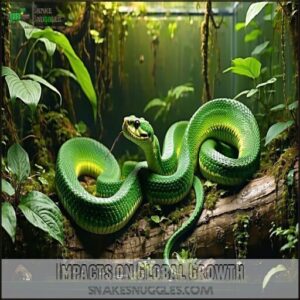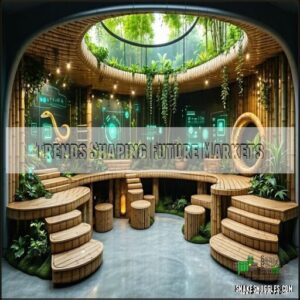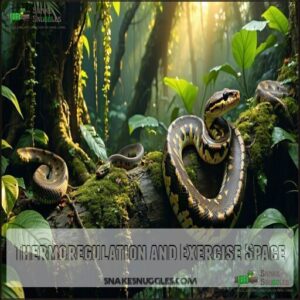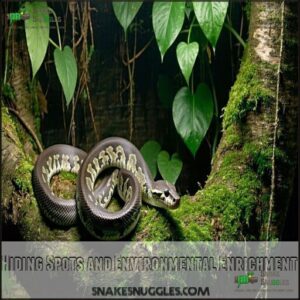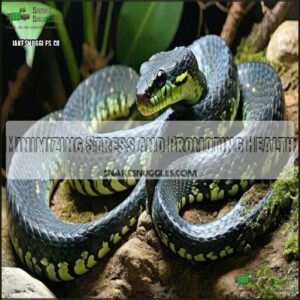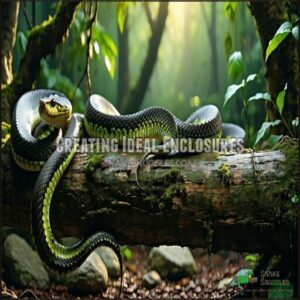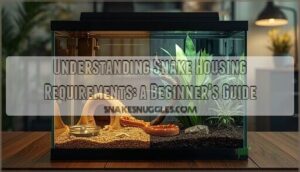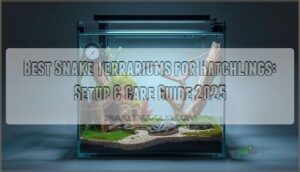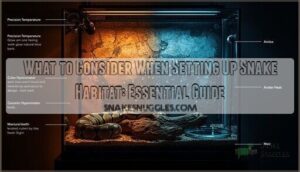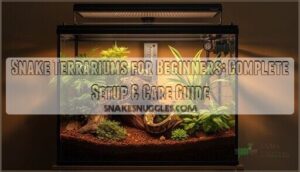This site is supported by our readers. We may earn a commission, at no cost to you, if you purchase through links.
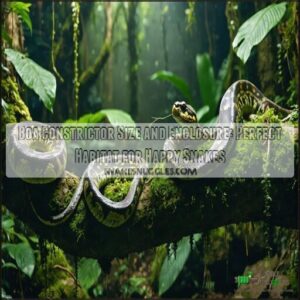 Boa constrictors can grow 6 to 10 feet long, with some females reaching 12 feet, so their enclosure has to match their impressive size.
Boa constrictors can grow 6 to 10 feet long, with some females reaching 12 feet, so their enclosure has to match their impressive size.
For adults, aim for at least an 8-foot-long enclosure, offering enough room for them to stretch out, explore, and stay active.
Juveniles thrive in smaller spaces initially, like a 4x2x2-foot terrarium, but they’ll outgrow it quickly.
Include hiding spots, climbing branches, and a well-regulated thermal gradient for peak health.
Boa constrictors are semi-arboreal, meaning they need both floor space and vertical climbing options.
A proper setup guarantees a healthy, stress-free snake while you hone your reptile-keeping skills.
Table Of Contents
Key Takeaways
- Make sure your boa’s enclosure matches its size, with adults needing at least 6x3x3 feet (males) or 8x3x3 feet (females) for proper movement and natural behaviors.
- Provide a temperature gradient (90–95°F basking, 75–80°F cool area) and maintain 50–70% humidity (higher during shedding) to mimic natural conditions.
- Add climbing branches, hiding spots, and secure furnishings to support their semi-arboreal nature and reduce stress.
- Don’t overcrowd or cohabitate boas; they thrive as solitary animals with proper feeding schedules based on their age and size.
Boa Constrictor Size Requirements
When caring for a boa constrictor, it’s essential to match its enclosure size to its length and activity needs.
Adult boas can grow up to 10 feet long, so providing a spacious, secure habitat guarantees their health and comfort.
Providing a spacious, secure habitat ensures your adult boa thrives while supporting natural behaviors and optimal health.
Adult Boa Length and Enclosure Size
When an adult boa reaches its impressive size of 6-10 feet, proper enclosure dimensions become essential.
For males, prioritize 6x3x3 feet, while larger females need 8x3x3 feet.
Don’t skimp on space—minimum enclosure size guarantees the boa can stretch fully and thrive.
Frequent enclosure upgrades reduce stress and allow natural behaviors, promoting health for both male and female boas.
Proper ventilation is also indispensable for their well-being.
Juvenile Boa Enclosure Needs
Juvenile boas, ranging from 2 to 5 feet long, need enclosures at least 4 feet by 2 feet by 2 feet.
This snake enclosure size accommodates their growth considerations and enrichment needs.
Include sturdy decor and ample hiding spots for security.
Many owners consider specialized juvenile products when setting up their boa’s habitat.
Regularly inspect their setup, as monitoring challenges arise with active juveniles.
Proper snake enclosure size supports healthy, natural behavior.
Baby Boa Housing Options
Baby boas, typically around two feet, need cozy spaces to thrive. A 2’x1.5’x1′ enclosure size works, but larger setups like 20-gallon tanks or grow-out tubs minimize frequent upgrades.
Add hides to reduce hatchling stress. For budget-friendly options, plastic storage tubs with holes offer ventilation.
Monitor defecation and avoid drowning risks by using shallow water bowls in their habitat. A larger enclosure allows the snake to fully stretch out.
Factors Affecting Boa Constrictor Size
Boa constrictor size depends on genetics, prey availability, and environmental conditions.
Boa constrictor growth thrives with the right balance of genetics, diet, and environment, ensuring a healthy and vibrant snake.
Subspecies variation also plays a role, with some boas naturally larger or smaller. Female boas are typically bigger than males due to sex differences.
To maximize growth potential:
- Provide consistent, appropriate prey.
- Maintain ideal temperatures and humidity.
- Monitor growth to guarantee your boa reaches its expected size.
Enclosure Design Considerations
When designing a boa constrictor’s enclosure, you’ll need to balance space, functionality, and the snake’s natural behaviors.
A well-planned setup guarantees your snake can stretch, thermoregulate, and feel secure at every stage of its growth.
Impacts On Global Growth
Boa growth heavily depends on smart enclosure design. Space needs shape a snake’s health, so matching boa enclosure size with snake size keeps them thriving.
A poorly designed habitat limits exercise and natural behaviors. Essential elements include proper ventilation systems for a healthy environment.
| Boa Size | Enclosure (LxWxH) | Description |
|---|---|---|
| Baby (2′) | 2’x1.5’x1′ | Compact but secure. |
| Juvenile (5′) | 4’x2’x2′ | Room for thermoregulation. |
| Adult (8′) | 8’x3’x3′ | Ideal stretch and comfort. |
Challenges In Policy Implementation
Implementing policies for snake enclosure standards isn’t easy; enforcement difficulties arise due to varying boa enclosure size needs for adult boa size versus baby boa size.
Resource allocation becomes tricky with large snake enclosures requiring more oversight. Public acceptance varies widely, and political obstacles often stall progress.
Unintended consequences, like gaps in regulations, can hinder effective enforcement, complicating compliance, due to enforcement difficulties and the need for effective enforcement.
Trends Shaping Future Markets
Future markets for snake enclosures are evolving with technological advancements and a push for sustainability.
Consumer behavior favors customizable setups, while economic shifts drive demand for durable, cost-effective designs.
Regulatory changes emphasize proper boa constrictor size housing.
Large snake enclosure trends prioritize modularity.
Space and Activity Needs
Your boa constrictor needs an enclosure that’s spacious enough to support proper movement, stretching, and thermoregulation.
Providing the right amount of space helps prevent stress, encourages natural behaviors, and promotes overall health.
Thermoregulation and Exercise Space
Providing proper thermoregulation is key to your boa’s health.
Use accurate temperature gradients—hot zones of 90°F and cooler areas near 75°F.
A spacious enclosure size guarantees exercise opportunities, promoting natural behaviors like stretching.
Complex habitats encourage movement and exploration.
Remember, consistent heating mimics the wild, helping your boa stay warm, active, and stress-free while exploring its mini wilderness.
Semi-Arboreal Behavior Accommodations
Juvenile boas thrive when their enclosure height supports vertical space for climbing opportunities.
Branch placement plays a significant role in snake enrichment, allowing arboreal hides and climbing branches for exercise.
Focus on juvenile enrichment with sturdy structures positioned for safe exploration.
Incorporate snake enclosure decor thoughtfully, fostering arboreal enrichment, and encouraging natural behaviors, ensuring your boa’s world feels expansive and engaging.
Hiding Spots and Environmental Enrichment
When creating a habitat for your boa, hiding spots and snake enrichment are essential for their well-being.
Use these ideas:
- Add arboreal hides using sturdy branches for climbing and resting.
- Incorporate naturalistic substrates like moss or soil for burrowing.
- Rotate decor regularly to encourage exploration.
- Include plant choices like Pothos for added cover and stimulation.
Secure furnishings for their safety!
Minimizing Stress and Promoting Health
A stressed boa is an unhealthy boa. Enclosure security, hiding adequacy, and enrichment variety contribute to stress reduction.
Provide zones for thermal regulation and humidity control to mimic natural conditions. Design your snake enclosure setup for growth and comfort.
One way to calm your snake is through gentle handling practices. Here’s a quick guide:
| Factor | Target Range | Importance | Examples |
|---|---|---|---|
| Temperature | 80-85°F daytime | Thermal Regulation | Heat lamps, basking bulb |
| Humidity | 40-60% | Health Maintenance | Coconut husk substrate |
| Hiding Spots | 2-3 per enclosure | Stress Reduction | Caves, cork bark |
| Enrichment Pieces | Rotated monthly | Mental Stimulation | Logs, hammocks, foliage |
Heating and Lighting Requirements
To keep your boa healthy, you’ll need to create a habitat that maintains proper temperatures and lighting.
Providing a basking spot, thermal gradient, and UVB light guarantees your snake can thermoregulate and thrive.
Basking Temperatures and UVB Lighting
Boa constrictors thrive when basking temps hit 90–95°F.
Use a basking bulb with proper wattage to maintain this.
Pair it with a UVB bulb to guarantee health, but replace it annually as output fades.
Monitor temperatures with a reliable device and make certain fixtures are snake-safe.
Drops to 70–75°F at night mimic natural cycles, supporting overall well-being.
Thermal Gradients and Nighttime Temperatures
A well-maintained temperature gradient is essential for your boa constrictor’s health.
Keep the basking spot at 90-95°F, while cooler areas stay around 75-80°F.
At night, allow a safe drop to 65-75°F, mimicking seasonal variation.
Temperature monitoring is key—avoid extremes.
Proper heating and UVB benefits support activity, digestion, and overall wellness, ensuring your snake thrives effortlessly.
Humidity Levels and Substrate Options
To maintain proper boa constrictor humidity, aim for 50-70%, increasing to 75-85% during shedding.
Choose a boa constrictor substrate that holds moisture yet prevents mold, like coconut fiber. Use a hydrometer placed near the substrate for accuracy.
Mist daily or adjust misting frequency based on humidity levels. Many keepers source their boa substrate needs from online retailers.
Follow these tips:
- Substrate Moisture: Retain high humidity for shedding.
- Shedding Humidity: Utilize sphagnum moss.
- Mold Prevention: Guarantee ventilation without overhydration.
- Hydrometer Placement: Position strategically near basking zones.
- Misting Frequency: Adjust misting for changing climates.
Lighting and Heating Equipment Recommendations
Lighting and heating are your boa’s lifelines.
Use heat lamps with safe wattage to create a steady basking spot.
UVB bulbs enhance health but replace them every 6-12 months—don’t trust their glow alone.
Proper thermostat placement guarantees precise temperature gradients.
For nighttime heating, consider ceramic heat emitters, avoiding light disturbance.
Many retailers offer boa heat lamps for reptile enclosures.
Keep your snake comfy and thriving!
Creating Ideal Enclosures
Creating an ideal enclosure for your boa constrictor guarantees it has enough space to stretch, thermoregulate, and roam comfortably.
By choosing the right materials, adding secure furnishings, and incorporating adjustable features, you can create a safe, stimulating habitat that meets your snake’s long-term needs, including the ability to thermoregulate.
Enclosure Size and Material Options
For boa constrictors, the required enclosure size hinges on their length and activity needs.
PVC enclosures excel in flexibility and ease of cleaning, while wood provides superior insulation.
Standard size options include 6x3x3 feet or larger, accommodating extensions for growth.
Expandable designs and color customization make enclosures versatile, ensuring your pet thrives within the right dimensions for comfort and health.
Customizable Features and Accessories
Craft your boa constrictor setup with customizable features for a perfect snake enclosure.
Expandable enclosures adapt to growth, while smart technology offers automated systems for lighting and heating.
Choose creative background designs for a natural look.
Enhance functionality with feeding solutions like removable feeding trays for easy cleaning.
These upgrades make maintaining the required enclosure size practical and your snake’s life more comfortable.
Rearranging Decor for Environmental Stimulation
Switching up your snake’s decor keeps its habitat fresh and engaging.
Regularly moving items like logs and plants promotes exploration encouragement and behavioral enrichment, reducing boredom.
Rearrange the enclosure thoughtfully to maximize stimulation benefits without overwhelming your pet.
UVA/UVB lighting needs should also be considered for your snake’s overall health.
Environmental enrichment boosts your snake’s natural curiosity, ensuring the snake enclosure remains both functional and dynamic, a perfect blend for pet stimulation.
Securing Furnishings for Snake Safety
Securing enclosure furnishings prevents injury and keeps your snake safe. Use fixture stability to avoid tip-over hazards. Watch for material toxicity, making certain items are snake-safe.
Follow cleaning protocols to stop bacteria buildup. Balance weight distribution so decor doesn’t shift unexpectedly.
- Make certain branches are screwed in tightly.
- Avoid escape risks—lock items securely.
- Skip tape—it’s unsafe.
- Test stability regularly.
Frequently Asked Questions (FAQs)
How often should boa constrictor enclosures be cleaned?
Clean their enclosure weekly for spot cleaning (removing waste or uneaten food) and deep clean monthly.
Replace soiled substrate, disinfect surfaces, and make certain everything’s dry before reassembling, so bacteria or mold don’t creep in, to ensure a clean environment and prevent the growth of bacteria.
What are the signs of stress in boas?
When your boa seems grumpier than a Monday morning, watch for tight curls, constant hiding, loss of appetite, excessive hissing, striking, or roaming.
These stress signals mean something’s off—temperature, handling, or enclosure setup likely need adjusting.
Can boa constrictors cohabitate with other snakes?
Cohabitating snakes can lead to stress, competition, and injuries, even in spacious enclosures.
Boa constrictors thrive alone, as solitary animals.
Mixing species or individuals typically risks aggression, illness spread, and feeding complications—best to house them separately.
How do feeding schedules vary by age?
Younger snakes eat weekly to fuel growth, while adults need food every 2-3 weeks to maintain body condition.
Adjust feeding based on prey size, snake activity level, and its overall health for ideal nutrition.
What is the ideal water source setup?
Provide a shallow water bowl sturdy enough to avoid tipping, wide for easy access, and cleaned regularly.
Make certain fresh water’s always available, maintaining humidity.
Spot-check for spills to keep the enclosure hygienic and safe.
Conclusion
Think of your boa constrictor’s enclosure as a canvas, creating the perfect blend of space, comfort, and function.
By understanding boa constrictor size and enclosure needs, you’ll provide an environment where your snake can thrive—stretching its body, climbing with ease, and staying stress-free.
Prioritize proper dimensions, hiding spots, thermal regulation, and enrichment to mimic their natural habitat.
A well-designed setup doesn’t just benefit your boa—it guarantees you enjoy the rewarding experience of keeping a healthy, active reptile.
- https://www.zenhabitats.com/collections/zen-habitats-reptile-enclosures?aff=5
- https://reptilekages.com/collections/premium-reptile-enclosures?ref=9
- https://www.facebook.com/groups/building.reptile.cages/
- https://www.inaturalist.org/observations?taxon_id=32092
- https://flickr.com/search/?text=boa%20constrictor%20wild


